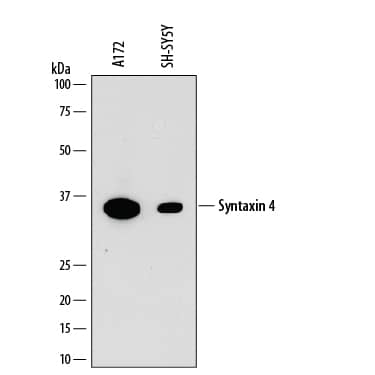Human Syntaxin 4 Antibody
R&D Systems, part of Bio-Techne | Catalog # MAB7894

Key Product Details
Validated by
Species Reactivity
Applications
Label
Antibody Source
Product Specifications
Immunogen
Met1-Glu183
Accession # Q12846
Specificity
Clonality
Host
Isotype
Scientific Data Images for Human Syntaxin 4 Antibody
Detection of Human Syntaxin 4 by Western Blot.
Western blot shows lysates of A172 human glioblastoma cell line and SH-SY5Y human neuroblastoma cell line. PVDF membrane was probed with 0.25 µg/mL of Mouse Anti-Human Syntaxin 4 Monoclonal Antibody (Catalog # MAB7894) followed by HRP-conjugated Anti-Mouse IgG Secondary Antibody (HAF018). A specific band was detected for Syntaxin 4 at approximately 36 kDa (as indicated). This experiment was conducted under reducing conditions and using Immunoblot Buffer Group 1.Syntaxin 4 in U‑87 MG Human Cell Line.
Syntaxin 4 was detected in immersion fixed U-87 MG human glioblastoma/astrocytoma cell line using Mouse Anti-Human Syntaxin 4 Monoclonal Antibody (Catalog # MAB7894) at 25 µg/mL for 3 hours at room temperature. Cells were stained using the NorthernLights™ 557-conjugated Anti-Mouse IgG Secondary Antibody (red; NL007) and counterstained with DAPI (blue). Specific staining was localized to plasma membranes and focal contacts. View our protocol for Fluorescent ICC Staining of Cells on Coverslips.Detection of Human Syntaxin 4 by Simple WesternTM.
Simple Western lane view shows lysates of SH‑SY5Y human neuroblastoma cell line, loaded at 0.5 mg/mL. A specific band was detected for Syntaxin 4 at approximately 42 kDa (as indicated) using 2.5 µg/mL of Mouse Anti-Human Syntaxin 4 Monoclonal Antibody (Catalog # MAB7894) . This experiment was conducted under reducing conditions and using the 12-230 kDa separation system.Applications for Human Syntaxin 4 Antibody
Immunocytochemistry
Sample: Immersion fixed U‑87 MG human glioblastoma/astrocytoma cell line
Immunoprecipitation
Sample: Cell lysate of HAP1 human near-haploid cell line.
Knockout Validated
Simple Western
Sample: SH‑SY5Y human neuroblastoma cell line
Western Blot
Sample: A172 human glioblastoma cell line and SH‑SY5Y human neuroblastoma cell line
Formulation, Preparation, and Storage
Purification
Reconstitution
Formulation
Shipping
Stability & Storage
- 12 months from date of receipt, -20 to -70 °C as supplied.
- 1 month, 2 to 8 °C under sterile conditions after reconstitution.
- 6 months, -20 to -70 °C under sterile conditions after reconstitution.
Background: Syntaxin 4
Syntaxin 4 (STX4) is a widely expressed type IV transmembrane protein that is a member of the syntaxin family of t‑SNARE (target‑Soluble NSF [N‑ethylmaleimide‑sensitive factor] Attachment REceptor) membrane fusion proteins (1, 2). For membrane fusion, VAMPs (Vesicle‑Associated Membrane Proteins, also called Synaptotagmins) as v‑SNAREs on donor (vesicle) membranes interact with t‑SNAREs and SNAPs (Soluble NSF Attachment Proteins) on target (cell surface) membranes, with SM (Sec1/Munc18-like) accessory proteins acting as catalysts for fusion (2). Human Syntaxin 4 cDNA encodes 297 amino acids (aa) including basolateral targeting motif for epithelial cells (aa 24‑29), a coiled‑coil domain termed Habc (aa 43‑163), an S‑nitrosylation site which regulates fusion (aa 141), a hinge region, a t‑SNARE domain (aa 200‑262), and a C‑terminal transmembrane domain (aa 276‑296) (1‑4). Within aa 1‑183, human Syntaxin 4 shares 89% aa sequence homology with mouse and rat, and 94‑95% with canine, bovine, equine, porcine, feline and ovine Syntaxin 4. Among its known roles, Syntaxin 4 and SNAP‑23 or SNAP‑25 associate with VAMP‑2 for fusion of GLUT4‑containing vesicles with the plasma membrane in muscle and adipose cells (1, 5). It is required for exocytosis of insulin from pancreatic beta‑cells (3, 6, 7). With SNAP23 and VAMP‑3, it allows endosome recycling to extend podosomes during macrophage migration (7‑9). It establishes polarization of epithelial cells, specifying basolateral sorting of proteins (4, 10). It mediates postsynaptic activity‑dependent exocytosis in neural cell dendritic spines (11). It is involved in exocytosis of ANP from cardiomyocytes (12). In FAS‑mediated apoptosis, it allows translocation of acid sphingomyelinase to the cell surface (13). Syntaxin 4 binds F‑actin and gelsolin, linking the plasma membrane with, or releasing it from, the actin cytoskeleton (6, 7).
References
- Jagadish, M.N. et al. (1996) Biochem. J. 317:945.
- Sudhof, T.C. and J.E. Rothman 2009 Science 323:474.
- Wiseman, D.A. et al. (2011) J. Biol. Chem. 286:16344.
- Reales, E. et al. (2011) PLoS One 6:e21181.
- Vicogne, J. et al. (2006) Proc. Natl. Acad. Sci. USA 103:14761.
- Jewell, J.L. et al. (2008) J. Biol. Chem. 283:10716.
- Kalwat, M.A. et al. (2012) Mol. Endocrinol. 26:128.
- Veale, K.J. et al. (2010) Commun. Integr. Biol. 4:44.
- Veale, K.J. et al. (2010) Exp. Cell Res. 317:1817.
- Low, S.H. et al. (2006) Mol. Biol. Cell 17:977.
- Kennedy, M.J. et al. (2010) Cell 141:524.
- Ferlito, M. et al. (2010) J. Mol. Cardiol. 49:791.
- Perotta, C. et al. (2010) J. Biol. Chem. 285:40240.
Alternate Names
Gene Symbol
UniProt
Additional Syntaxin 4 Products
Product Documents for Human Syntaxin 4 Antibody
Product Specific Notices for Human Syntaxin 4 Antibody
For research use only




